By Somali K Chakrabarti
It was 1 PM in the afternoon. After lapping up all there was to seen in Pattadakal and Aihole, we proceeded towards Hampi, which is at distance of around 150 km from Aihole. The stretch of road between Aihole and Hampi being smooth, we had an easy drive.
On the way, as we passed through Kamalapur, we saw a lake in which the water had a pinkish tinge, appearing as if it had borrowed its shade from the nearby reddish hills.

Reaching Hampi by 3.30 pm, we checked into KSTDC. As it was very late, we ordered for a simple Daal Khichdi. While having food in the food court, I heard some loud thud sounds from the roof. I wondered if some tree branches had fallen on the roof, only to realize that it was the sound of monkeys jumping on the roof. The waiter told us not to worry as they would not come down. Quickly finishing up our lunch, we left for seeing Hampi.
A UNESCO heritage site, Hampi was the capital of the Vijayanagar empire from the 14th to 16th century.
‘A city as large as Rome and very beautiful to the sight’.
is how the ancient foreign tourists described the city of Vijayanagara, as it was then known.
Many forts, ramparts, temples and statues can be seen all throughout the city, aesthetically blending with the rocks and boulders.
Virupaksha Temple
We started our tour of Hampi with the Virupaksha Temple, the oldest of all temples in Hampi. Also called Pampapathi, the temple is dedicated to Shiva.
The 165 ft tall entrance of the tower is visible from a distance. As we parked and walked towards the temple, a vendor girl told us that there is an elephant inside the temple and sold us a bunch of bananas for the elephant. But she didn’t tell us about the monkeys inside the temple, who were quick enough to snatch some of the bananas just as we entered the temple complex.
By the way, Hampi also finds mention in the epic Ramayana as Kishkinda, the kingdom of monkeys, ruled by Vaali and later by Sugreeva.
Coming back to the temple elephant, the interesting thing I noted about the elephant was that when someone offered money, the elephant would deftly pick up the money with its trunk, give it to his handler and bless the person.
Here I am getting blessed. 🙂
After sometime, the elephant was taken away for a dip in the water of Tungabhadra river that flows by the temple.
The light at the tip of the temple peak now glowed in the twilight. We stood for darshan as the priests performed the Puja, and took the prasadam.
Vittala Temples
On the next day we went to the famous Vittala (Vishnu) temple, the exquisite architectural showpiece of Hampi.
The car park is at quite some distance from the temple. An electric cart took us to the temple. From the cart, we could see pillars on both sides of the temple, which used to be the open shops on the way to the temple. It is said that diamonds, crystals and other precious stones were sold openly in these shops. Religion and commerce have co-existed since ages.
Inside the large complex are many pillared halls, temples and a chariot. It must have been an extraordinarily beautiful sight in its prime.
The main attraction of this temple are the monolithic pillars, with the most intricate carvings. The outermost pillars in one of the elevated open halls called the Maha-Mantapa are popularly musical pillars. These emit musical tones when tapped.
The famous stone chariot stands right in the centre of the complex. The Vijayanagar Kings seem to have built the chariot after being inspired by the Sun Temple at Konark in Odisha.
Lotus Mahal
A place worth mentioning is the eight angled Lotus Mahal built in the Indo- Muslim style. This used to be the place where the King would relax and have conversations. A garden around the structure enhances its beauty.
Adjacent to the garden of the Lotus Mahal, separated by a high stone wall are the royal stables which sheltered the royal elephants of the king of Vijayanagar.
Lakshmi Narasimha
Hidden away from the main road is a huge idol of Narasimha. This idol is not inside a temple but in an open place. The 22 ft tall idol is carved of a single stone. Unfortunately many parts of the idol are damaged.
Other than these place, we went to the Museum, Queen’s bath, a podium known as Mahanavami Dibba, which once had a hall with fragrant sandalwood pillars standing on it, a pond known as Pushkarani and Sasivekala Ganesha, and Sri Krishna Temple.
Next day we started off for Manipal, with my mind and heart filled to the brim with the richness of the cultural past of the places.
The Karnataka government sponsors a 3- day celebration called ‘Hampi Utsav’ each year between November and January. They have also proposed a tie up with Peru for promoting Hampi and Machu Pichu as twin heritage sites.
If you like this post, please consider following the blog.
Please like, share and/or leave feedback in comments below! ![]()
.

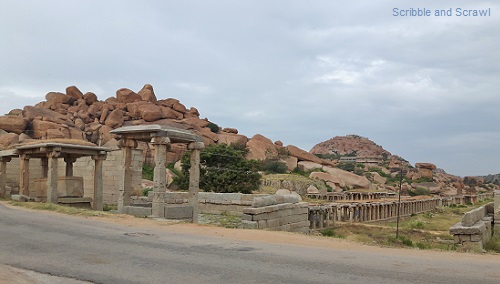
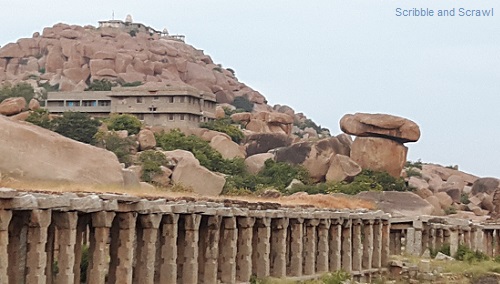
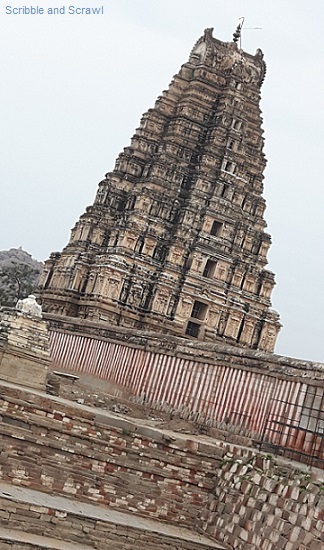
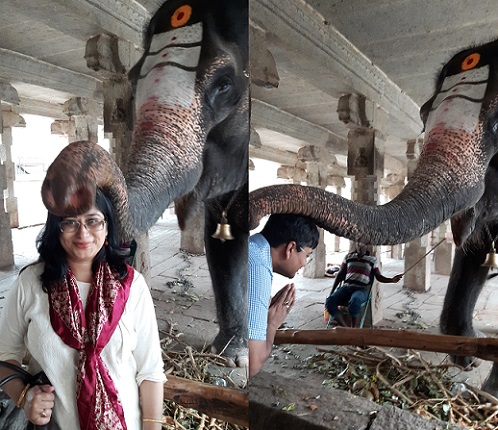
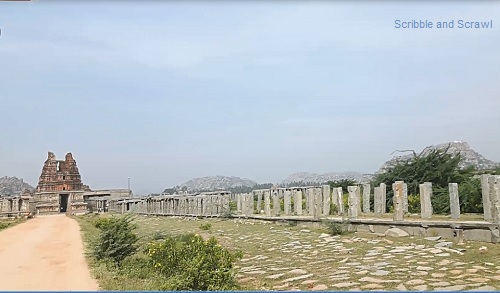
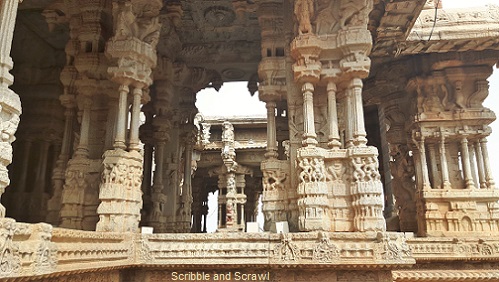
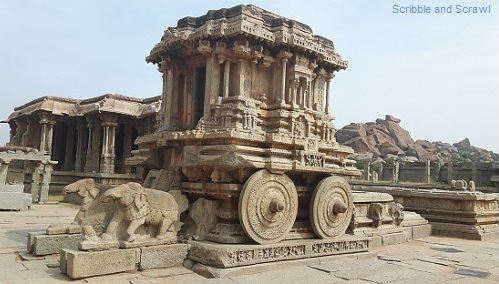
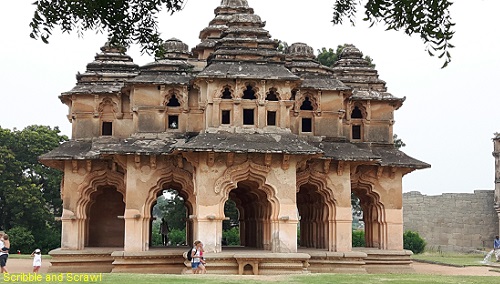
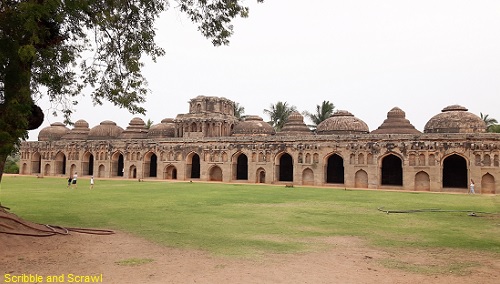
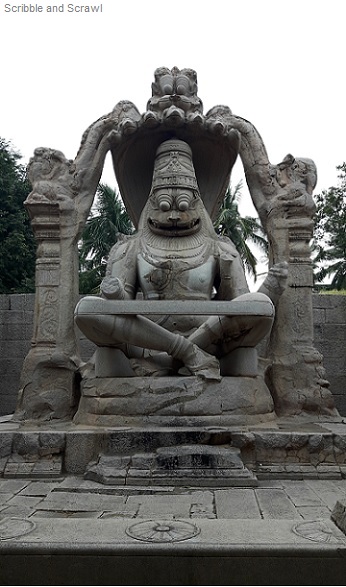
Wonderful post. The photographs are lovely. 🙂
LikeLiked by 1 person
Thank you Amitav.
LikeLike
Welcome. 🙂
LikeLiked by 1 person
I keep reading about Hampi – hope to go there some day soon. I absolutely love the photo of you with the elephant. Adorable!
LikeLiked by 1 person
Thank you Kalpana. Hope you plan out a trip soon. I was elated when the elephant blessed, at the same time hoped that it doesn’t deviate from its SOP. 😀
LikeLike
Hampi is an ancient and historical town town . Since the rule of Vijayanagar king it is almost same as it was then at that time. really beautiful site to visit. Kamalapur lake is looking very nice and pink as you mentioned . I have a question Somali ji, here in a picture, The Virupaksh temple is tilted ,it is in actual or in pic only ?
LikeLiked by 1 person
Thank you Yogiji. The Virupaksha temple is not tilted. I just took the picture at an angle to capture the entire length from the tip of temple peak to the steps of the well . 🙂
LikeLike
I keep coming back here Somali, like bees to the honey…captivating pictures especially the elephant’s trunk on you! Truly blessed! The Virupaksha temple is an archaeological marvel !
LikeLiked by 1 person
Thank you Sunita. Very kind of you to say so. Archaeological marvels these temples truly are!
LikeLike
[…] Pattadakal, Aihole and Hampi in Karnataka have special significance in the history of Indian temple architecture. Numerous […]
LikeLike
Amazing photos…India continues to surprise me with astonishing pictures of their ancient civilization…thanks for sharing these…
LikeLiked by 1 person
Thank you so much for stopping by. Many of these ancient structures have amazing intricacy of artwork, but unfortunately they have either been destroyed or not have been well maintained. Thankfully, some effort can be seen towards the restoration of these structures.
LikeLiked by 1 person
🙂 i think there are still pictures about India that are worth seeing and to be posted… 🙂 i’ll wait for those photos… 🙂 LOL…
LikeLiked by 1 person
😀 😀
LikeLiked by 1 person
I had read about Hampi during my college days in our syllabus : The Indian Architecture by Percy Brown, so somewhat knew about what to expect. But, I wasn’t prepared for such beauty!
I believe, those are carved in sandstone. Loved that Temple Elephant and his tricks with money. 😀
It seems like very lovely place! Thanks for sharing it, Somali! 🙂
LikeLiked by 1 person
Thank you Rakesh. The pillars are supposed to be monolithic granite pillars designed to produce musical sound by tapping. Indeed these are lovely places and they showcase how architectural styles from different parts of India blended and evolved over time.
The elephant looked rather special with a big orange tika on its forehead. 🙂
LikeLiked by 1 person
Actually!
Monolithic to samjha, but how about musical? It seems, they were hollowed out to produce the timber. Can you imagine the efforts taken to hollow out a huge pillar of granite, which is considered the hardest of all the igneous rocks?
It’s actually great to have friends, who wander around the world and make one cognizant of the wonders, which hitherto one had seen only in magazines and books! Keep discovering new horizons! 🙂
LikeLiked by 1 person
Nahi nahi Rakesh, they are not hollowed out. That is what baffled many people. In fact , during the British period, they took away some columns, tested them and confirmed that these were solid. How these produced musical sound could not be deciphered. That remains a mystery till now.
LikeLike
Wow! Reminds me of the 5 fountains of the Mughal Garden at Agra Fort. No pipelines, still they function. British dismantled one and couldn’t find any connection. It stopped working, but the remaining four still worked. Don’t know if it’s the truth, but have read about it somewhere.
LikeLiked by 1 person
Yes, they say that for Agra Fort. The ducts for cooling the walls are interesting too. The jali work at Fatehpur Sikri is also pretty attractive and was designed so that the ladies could see the events without themselves being seen.
LikeLike
Wonderful narrative, Somali. I love your photo with the elephant. It’s so cute. 🙂
LikeLiked by 2 people
Thank you Kiran. 🙂
LikeLike
Thanks for this post… I am planning to be there soon… looking forward to it
LikeLike
Such amazing architecture! What wonderful artistic minds! Thank you for bringing it into my little world, Somali!
LikeLiked by 1 person
Thank you for reading and commenting Johann. Yes can’t help marveling at those who designed them.
LikeLike
Thank you for sharing your photos and your thoughts. I have to admit, monkeys jumping on to the roof of my car might be a little anxiety producing. :0
LikeLiked by 1 person
Thank you. Luckily for us the monkeys were not jumping on the roof of the car but on the roof of the food court. 😀
LikeLike
Wonderful post. The photographs are lovely.
LikeLiked by 1 person
Thank you Jamshed.
LikeLike
So much history in 1 single place! Can’t imagine how the 165 feet tall temple and the 22 feet deity carved from single stone would have been made without “modern tools” as we call them today. They already had them back then I should imagine. Amazing. Very nice pics and write up. Thanks Somali
LikeLiked by 1 person
Thank you Kamalji. Yes, these places, with their marvellous architecture leave us awestruck.
LikeLiked by 1 person
Good post Somali!
Very interesting to find out about the historical site which we only studied in school. We all are fascinated by Roman architecture and thousands go there every year to visit but such places in India are not advertised well for people to go and visit.
I will need to put it in the list of places to visit.
LikeLiked by 1 person
Exactly Nitish. We are fascinated by Roman architecture but do not really know about these exquisite places in India. Lack of awareness and access could be the reason. Thankfully some of the places are being restored to look like how they originally looked during the prime time.
LikeLike
You have compressed so much into this post Somali! I marvel at your narration, you can be a good historian. It seems you had a wonderful time and those blessings from an elephant adds so much charm to this pictorial treat. Thanks for making me a part of your visit to these sites of our iconic heritage.
LikeLiked by 2 people
Thanks a lot Balroop for such kind words. Writing down the experiences along with pics helps in recording the good memories and sharing. Happy to do that. 🙂
LikeLike
Great post, Beautiful photos
LikeLiked by 1 person
Thank you Rupam.
LikeLike
Delightful post and colourful photographs about Hampi.
LikeLiked by 1 person
Thank you so much.
LikeLike
Somali, this temple site is so brilliant in its architecture and you have very beautifully captured its magnificence. Loved the pic where you are taking blessings from the smartly trained elephant 🙂
LikeLiked by 1 person
Thank you very much Bushra. Yes its a place worth a visit…and the elephant amuses with the antics. 🙂
LikeLike
Great description. Beautiful pictures. It is in my bucket list for a visit.
LikeLiked by 1 person
Thank you sir. You’ll surely like the place steeped in history, art and architecture.
LikeLike
terrific pix Somali!
LikeLiked by 1 person
Thank you Sharmistha
LikeLike
Amazing article and great pictures
Kanchan had been sharing a few URL s in the past and this article of yours interested me.
Have worked with Kanchan (KC) in PG and Makers as we used to call him in RIL
LikeLiked by 1 person
Thanks for your kind words. Happy to see a comment from KC’s colleague. 🙂
LikeLike
Indeed a city of Iconic heritage. The picture of you with elephant, adorable. Lovely post S.
LikeLiked by 1 person
Thank you Ankita. It was an enriching experience to visit this place.
LikeLiked by 1 person
Lovey pictures and excellent narration. Love your images of getting blessed by an elephant. 🙂
LikeLiked by 1 person
Thank you Sir. Indeed it was fun getting blessed by the elephant.
LikeLiked by 1 person
I’ve heard so much about Hampi! The famous stone chariot, the status..all singing paeans of the heydays of Indian architecture. Great pictures and I loved your pic…the elephant blessing you..so sweet..:-)
LikeLiked by 1 person
Thank you Maniparna. I think I had read about Hampi mainly in some blogs and always wanted to see the chariot and pillars. Its amazing to see how deftly the elephant uses its trunk to pick up the note. 🙂
LikeLiked by 1 person
Lovely post and photos especially the photo were you are being blessed by the elephant.:)
LikeLiked by 1 person
Thank you Kashpals. I quite enjoyed the blessing. 🙂
LikeLiked by 1 person
Planned a long back to Hampi but couldn’t go.Lovely write up and beautiful photos.Love the blessing shot so much.
Cheers,
Sriram & Krithiga
LikeLiked by 1 person
Thank you Sri anf Kri. Whenever you go to Hampi, you are bound to like it.
LikeLike
Nice Writing… good Information too!
LikeLiked by 1 person
Thank you GKD.
LikeLiked by 1 person
Wow amazing post! I love the photos and your descriptions!
LikeLiked by 1 person
Thank you Lynz. 🙂
LikeLiked by 1 person
most welcome
LikeLiked by 1 person